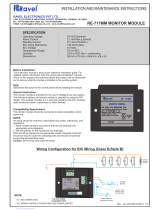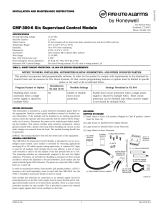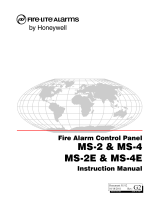Page is loading ...

COMPONENTS
Following are descriptions of the IM-10 mounting frameworks. There are two
mounting options for IM-10 modules:
• Up to six IM-10 modules can be installed on a CH-6 in a BB-6 cabinet
• One or two IM-10 modules can be installed in a BB-2 cabinet
CHASSIS
The CH-6 chassis is used to mount IM-10 modules in a BB-6 cabinet. It accom-
modates up to six IM-10 modules in a single cabinet row three modules wide
and two modules deep.
FIGURE 1. CH-6 CHASSIS:
The BB-2 cabinet has a built-in chassis that will accommodate one or two
IM-10 modules.
FIGURE 2. BB-2 CABINET:
0
1
2
3
4
5
6
7
8
9
0
7
8
6
5
4
3
2
1
9
10
11
12
13
14
15
BASE ADDRESS
ADDRESS
DISABLE
NONE
ONE
TWO
THREE
0
1
2
3
4
5
6
7
8
9
0
7
8
6
5
4
3
2
1
9
10
11
12
13
14
15
BASE ADDRESS
ADDRESS
DISABLE
NONE
ONE
TWO
THREE
The front IM-10 module positions of each chassis are offset below the rear IM-
10 module positions so that all of the status indicators are visible.
CABINETS
A BB-6 cabinet will house the CH-6 chassis with up to six IM-10 modules in-
stalled on it. Refer to cabinet installation documents for dimensions.
The BB-2 cabinet houses one or two IM-10 modules on the internal chassis
that is part of the cabinet. Refer to cabinet installation documents for dimen-
sions.
BEFORE INSTALLING
This information is included as a quick reference installation guide. Refer to
the appropriate control panel installation manual for detailed system infor-
mation. If the modules will be installed in an existing operational system,
inform the operator and local authority that the system will be temporarily
out of service. Disconnect the power to the control panel before installing the
modules. This system contains static sensitive components. Always ground
yourself with a proper wrist strap before handling any circuits so that static
charges are removed from the body. The housing cabinet should be metallic
and suitably grounded.
NOTICE: This manual should be left with the owner/user of this equipment.
GENERAL DESCRIPTION
The IM-10 Ten Input Monitor Module is intended for use in an intelligent
alarm system. Each monitor module is intended to interface between a control
panel and normally open contact devices, such as pull stations. A common
SLC input is used for all modules, and the initiating device loops share a
common supervisory supply and ground. Otherwise, each monitor operates
independently from the others. Each module has its own unique address.
A pair of rotary code switches is used to set the address of the first module
from 01 to 90. The remaining modules are automatically assigned to the next
nine higher addresses. Provisions are included for disabling a maximum of
two unused modules to release the addresses to be used elsewhere. Each mod-
ule also has panel controlled green LED indicators. The panel can cause the
LEDs to blink, latch on, or latch off.
INCLUDED:
(6) 1 x 4 Terminal Blocks (2) 1¼" (32mm) Stand offs
(4) Machine Screws (2) Nuts (3) Shunts (10) 47k Ohm
End of Line Resistors
Shipped on Board:
(1) Shunt in Class A/B position
(Shipped in Class B position, remove shunt for Class A)
COMPATIBILITY REQUIREMENTS
To ensure proper operation, this module shall be connected to a listed compat-
ible system control panel.
INSTALLATION AND MAINTENANCE INSTRUCTIONS
IM-10
Ten Input Monitor Module
SPECIFICATIONS
Normal Operating Voltage: 15–32 VDC
Stand-By Current: 3.75 mA @ 24V
Alarm Current: 60 mA (assumes all ten LEDs solid on)
Temperature Range: 32°F to 120°F (0°C to 49°C)
Humidity: 10 to 93% Non-condensing
Dimensions: 6.8˝H x 5.8˝W x 1.25˝D
Accessories: CH-6 Chassis; BB-6 Cabinet; BB-2 Cabinet
Wire Gauge: 12-18 AWG
Maximum IDC Wiring Resistance: 40 Ohms
Maximum IDC Voltage: 12 VDC
Maximum IDC Current: 1 mA
3825 Ohio Avenue, St. Charles, Illinois 60174
1-800-SENSOR2, FAX: 630-377-6495
www.systemsensor.com
C0202-00
C0206-00
I56-1797-010
C0885-00
1 I56-1797-010
03-11

Step 3: Align two 4-40 screws with the two standoffs and tighten.
Step 4: Address and wire the modules according to the instructions in this
manual.
The steps in Figures 6a and 6b describe and illustrate module installation
when the rear chassis position and the position in front of it will be filled.
Front position installation is possible only if the rear position is filled with
another module.
FIGURE 6A. INSTALLATION OF IM-10 MODULE IN A REAR CHASSIS
POSITION, METHOD TWO:
1
Step 1: Insert the bottom edge of the IM-10 module down into a rear slot of
the chassis.
Step 2: Carefully swing the upper edge of the board towards the back of the
chassis until it touches the short standoff attached to the chassis.
Step 3: Align the long standoff with the short standoff and tighten.
FIGURE 6B. INSTALLATION OF IM-10 MODULE IN FRONT CHASSIS
POSITION:
2
3
1
Step 1: Insert the bottom edge of the IM-10 module down into a front slot of
the chassis.
Step 2: Carefully swing the upper edge of the board towards the back of the
chassis until it touches the 11/4˝ (31.75mm) standoffs installed on
the rear module.
Step 3: Align two 4-40 screws with the two standoffs and tighten.
Step 4: Address and wire the modules according to the instructions in this
manual.
WIRING
NOTE: All wiring must conform to applicable local codes, ordinances, and
regulations.
1. Install module wiring in accordance with the job drawings and appropri-
ate wiring diagrams.
2. All wiring to the IM-10 is done via terminal blocks. In order to properly
make electrical connections strip approximately 1/4˝ of insulation from
the end of wire, sliding the bare end of the wire under the clamping plate
screw.
3. Set the address on the modules per the job drawing. Use the rotary code
switches to set the address of the first module (between 01 and 90).
In Class B operation, the remaining modules are automatically assigned
to the next nine higher addresses. For example, if the base address switch
is set to 28, the next nine modules will be addressed to 29, 30, 31, 32, 33,
34, 35, 36, and 37.
INSTALLATION STEPS
1. Cabinet Mounting
In a clean, dry area, mount the backbox using the four holes provided in
the back surface of the cabinet (Figure 3).
2. Chassis Installation
The CH-6 chassis is mounted in the BB-6 cabinet. It is shipped with two
self-threading screws, which are used to fasten the chassis to the back
wall of the cabinet (see Figure 4).
FIGURE 3. TYPICAL MOUNTING HOLE LOCATIONS:
BACKBOX
MOUNTING
HOLES
FIGURE 4. MOUNTING THE CH-6 CHASSIS:
MOUNT WITH
SELF-THREADING SCREWS
TO BACK OF CABINET
The BB-2 cabinet comes with the chassis already installed, so no mounting
is necessary.
3. Module Installation
There are two methods for installing a module in the rear position of a
chassis. Method one is for installation of a rear module only, when no
module will be installed in front of it. Refer to Figure 5 for instructions.
Method two is for installation of a rear module when another module
will be installed in the chassis position in front of it. Refer to Figures 6a
and 6b for method two. All necessary screws and standoffs are supplied
with the modules.
FIGURE 5. INSTALLATION OF REAR MODULE ONLY, METHOD ONE:
2
3
1
Step 1: Insert the bottom of the IM-10 module down into a rear slot on the
chassis.
Step 2: Carefully swing the upper edge of the board back towards the back of
the chassis until it touches the two standoffs.
C0237-00
C0235-00
C0236-00
C0225-00
C0226-00
2 I56-1797-010
03-11

The module is shipped in Class B position, remove shunt for Class
A. When operating in Class A, alternate modules are paired together
(+0/+1, +2/+3, +4/+5, +6/+7, +8/+9), resulting in a total of five
modules. For example, if the base address switch is set to 28, then 30,
32, 34 and 36 will be automatically assigned to the modules while 29, 31,
33, 35 and 37 are available to be used for other modules on the SLC. For
Class A and B operation, DO NOT set the lowest address above 90, as the
other modules will be assigned to nonexistent addresses.
4. A shunt is provided to disable a maximum of two unused modules in
Class B operation and one unused module in Class A operation. Modules
are disabled from the highest address and work downward. If two mod-
ules are disabled, the lowest eight addresses will be functional, while the
0
1
2
3
4
5
6
7
8
9
BASE ADDRESS
TO NEXT
DEVICE
–
STATUS
INDICATORS
—
+
—
+
—
+
—
+
—
+
—
+
IDC
ADDRESS
+0
+1
+2
+3
+4
+5
+6
+7
+8
+9
IDC
ADDRESS
IDC
ADDRESS
IDC
ADDRESS
IDC
ADDRESS
—
+
—
+
SLC
—
+
—
+
+
–
+
FROM PANEL OR
PREVIOUS DEVICE
47K
EOL
RESISTOR
A2143-00
CONNECT MODULES TO
LISTED COMPATIBLE
CONTROL PANELS ONLY
SIGNAL LINE CIRCUIT 32 VDC MAX.
TWISTED PAIR IS RECOMMENDED.
CLASS B IDC (TYPICAL)
—
+
—
+
A/B SLCT
COM LOSS
DISABLE 1
DISABLE 2
0
1
2
3
4
5
6
7
8
9
POWER LIMITED
AND SUPERVISED
NOTE: Any number of UL listed contact closure devices may be used. DO NOT mix fire alarm initiating and supervisory devices on the same initiating device
circuit. Install contact closure devices per manufacturer’s installation instructions.
NOTE: Any number of UL listed contact closure devices may be used. DO NOT mix fire alarm initiating and supervisory devices on the same initiating device
circuit. Install contact closure devices per manufacturer’s installation instructions.
BASE ADDRESS
TO NEXT
DEVICE
–
STATUS
INDICATORS
—
+
—
+
—
+
—
+
—
+
—
+
IDC
ADDRESS
+0
+1
+2
+3
+4
+5
+6
+7
+8
+9
IDC
ADDRESS
IDC
ADDRESS
IDC
ADDRESS
IDC
ADDRESS
—
+
—
+
SLC
—
+
—
+
+
–
+
FROM PANEL OR
PREVIOUS DEVICE
CONNECT MODULES TO
LISTED COMPATIBLE
CONTROL PANELS ONLY
SIGNAL LINE CIRCUIT 32 VDC MAX.
TWISTED PAIR IS RECOMMENDED.
—
+
—
+
A/B SLCT
COM LOSS
DISABLE 1
DISABLE 2
IDC 2
IDC 3
IDC 4
IDC 5
0
1
2
3
4
5
6
7
8
9
0
1
2
3
4
5
6
7
8
9
POWER LIMITED
AND SUPERVISED
CLASS A IDC (TYPICAL)
*Remove shunt for Class A operation.
FIGURE 7. TYPICAL INITIATING DEVICE CIRCUIT CONFIGURATION – CLASS B, STYLE B:
FIGURE 8: TYPICAL FAULT TOLERANT INITIATING DEVICE CIRCUIT CONFIGURATION – CLASS A, STYLE D
C0887-01
C0886-01
highest two will be disabled. For example, in Class B operation, if the
shunt for Address Disable is placed on “two” and the base switch is set
to 28, the modules will be assigned to 28, 29, 30, 31, 32, 33, 34 and 35
while disabling the highest two positions.
NOTE: Place unused shunts on single pin to store on board for future use.
NOTE: Power must not be applied to the unit when changing functionality
of the shunts.
WIRING NOTES
• Power-limited circuits must employ type FPL, FPLR, or FPLP cable as
required by Article 760 of the NEC.
NOTE: All references to power limited represent “Power Limited (Class 2)”.
3 I56-1797-010
03-11

System Sensor warrants its enclosed product to be free from defects in materials and
workmanship under normal use and service for a period of three years from date of
manufacture. System Sensor makes no other express warranty for the enclosed product.
No agent, representative, dealer, or employee of the Company has the authority to in
-
crease or alter the obligations or limitations of this Warranty. The Company’s obligation
of this Warranty shall be limited to the replacement of any part of the product which is
found to be defective in materials or workmanship under normal use and service during
the three year period commencing with the date of manufacture. After phoning System
Sensor’s toll free number 800-SENSOR2 (736-7672) for a Return Authorization number,
send defective units postage prepaid to: Honeywell, 12220 Rojas Drive, Suite 700, El Paso
THREE-YEAR LIMITED WARRANTY
TX 79936 USA. Please include a note describing the malfunction and suspected cause
of failure. The Company shall not be obligated to replace units which are found to be
defective because of damage, unreasonable use, modifications, or alterations occurring
after the date of manufacture. In no case shall the Company be liable for any consequen
-
tial or incidental damages for breach of this or any other Warranty, expressed or implied
whatsoever, even if the loss or damage is caused by the Company’s negligence or fault.
Some states do not allow the exclusion or limitation of incidental or consequential dam
-
ages, so the above limitation or exclusion may not apply to you. This Warranty gives you
specific legal rights, and you may also have other rights which vary from state to state.
FCC STATEMENT
This device complies with part 15 of the FCC Rules. Operation is subject to the following two conditions: (1) This device may not cause harmful interference, and (2) this device must
accept any interference received, including interference that may cause undesired operation.
NOTE: This equipment has been tested and found to comply with the limits for a Class B digital device, pursuant to Part 15 of the FCC Rules. These limits are designed to provide
reasonable protection against harmful interference in a residential installation. This equipment generates, uses and can radiate radio frequency energy and, if not installed and used in
accordance with the instructions, may cause harmful interference to radio communications. However, there is no guarantee that interference will not occur in a particular installation.
If this equipment does cause harmful interference to radio or television reception, which can be determined by turning the equipment off and on, the user is encouraged to try to
correct the interference by one or more of the following measures:
– Reorient or relocate the receiving antenna.
– Increase the separation between the equipment and receiver.
– Connect the equipment into an outlet on a circuit different from that to which the receiver is connected.
– Consult the dealer or an experienced radio/TV technician for help.
4 I56-1797-010
©2016 System Sensor. 03-11
/




